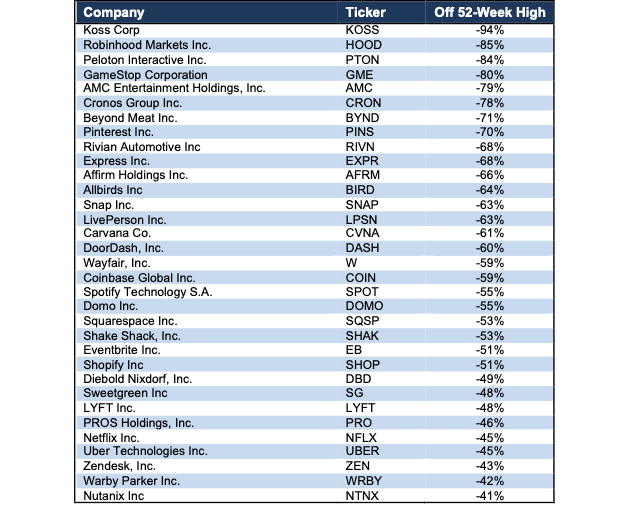We published an update on this Danger Zone pick on August 10, 2022. A copy of the associated report is here.
We counsel investors to take care not to be cut by falling knives – stocks that have seen steep declines but still have further to fall. As the market rotates away from high-flying growth names to more stable cash generators, investors need reliable fundamental research, more than ever, to protect their portfolios from falling knives.
We continue to post an exceptional hit rate on spotting overvalued stocks. Currently, 62 out of our 65 Danger Zone stock picks are down from their 52-week highs by more than the S&P 500. Figure 1 lists the open Danger Zone picks that are down at least 40% from their 52-week highs. Our Focus List Stocks: Short Model Portfolio, the best-of-the-best of our Danger Zone picks, outperformed the S&P 500 as a short portfolio by 36% in 2021 with 29 out of our 31 picks outperforming the index.
This report highlights one particularly dangerous falling knife: DoorDash (DASH: $104/share). We highlight four other falling knives in other reports published today: Uber (UBER: $35/share) here, Affirm (AFRM: $60/share) here, Rivian (RIVN: $60/share) here, and Warby Parker (WRBY: $35/share) here. Each of these stocks have dropped at least 40% from all-time highs, yet still carry at least 40% additional downside risk.
Figure 1: Danger Zone Picks Down >40% From 52-Week High – Performance through 1/28/22
Sources: New Constructs, LLC
Falling Knife: DoorDash (DASH): Down 60% from 52-Wk High & 67%+ Downside Remaining
We named DoorDash (DASH) one of the most dangerous stocks for fiduciaries in November 2020 when we called it The Most Ridiculous IPO of 2020. Since the opening price on IPO date, the stock is down 43% while the S&P 500 is up 20%, and DoorDash shares could fall another 67%. We detail DoorDash’s lack of profitability, low-switching costs in the delivery industry, and other challenges facing the company in our most recent report here.
Valuation Implies DoorDash Owns 94% of 2030 TAM
A reverse DCF analysis shows DoorDash’s stock price implies huge improvement in market share and profit margins, metrics that are unlikely to improve simultaneously in a competitive market.
To justify its current price of ~$104/share, DoorDash must:
- Immediately improve its NOPAT margin to 7.6% (average of logistics providers United Parcel Service and FedEx’s TTM NOPAT margin, compared to DoorDash’s margin of -15% in 2020 and -7% in 3Q21),
- grow revenue by consensus estimates in 2021, 2022, and 2023, and
- grow revenue by 25% (above consensus estimate in 2023 and 2.5x expected industry growth) each year thereafter through 2030.
In this scenario, DoorDash would earn nearly $36 billion in revenue in 2030. At its 3Q21 take rate of 12.2%, this scenario equates to ~$294 billion in marketplace gross order volume (GOV) for DoorDash in 2030. Take rate measures the percentage of GOV DoorDash captures as revenue.
In other words, to justify DoorDash’s current price of ~$103/share, the firm must capture 94% of the projected 2030 global food delivery TAM[1], compared to ~32% over the trailing twelve months.
67% Downside Even if DoorDash Matches Industry Growth
DoorDash’s economic book value, or no growth value, is negative $33/share, which illustrates the overly optimistic expectations in its stock price.
Even if we assume DoorDash:
- improves its NOPAT margin to 6% (equal to FedEx’s TTM NOPAT margin),
- grows revenue by consensus estimates in 2021, 2022, and 2023, and
- grows revenue by 11% (expected industry CAGR through 2028) each year thereafter through 2030, then
the stock is, optimistically, worth just $34/share today – a 67% downside. Even in this scenario, DoorDash would earn $15.3 billion in revenue in 2030. At its 3Q21 take rate, this scenario equates to over $125 billion in gross order volume in 2030, which would equal 40% of the projected 2030 TAM.
This scenario may prove too optimistic as it assumes a significant improvement in NOPAT margin in an increasingly commoditized industry.
Figure 2 compares DoorDash’s implied future gross order volume in these scenarios to its historical GOV. For reference, we also include the bookings of Uber, which represent the total dollars spent on Uber’s platform, similar to DoorDash’s GOV metric. DoorDash’s current stock price implies its GOV ten years from now will be nearly four times greater than Uber’s TTM bookings.
Figure 2: Historical GOV vs. Implied GOV: DCF Scenarios
Sources: New Constructs, LLC and company filings.
Each of the above scenarios assume DoorDash grows revenue, NOPAT, and FCF without increasing working capital or fixed assets. This assumption is highly unlikely but creates best-case scenarios that demonstrate how high expectations embedded in the current valuation are. For reference, DoorDash’s invested capital increased $813 million (92% of 2019 revenue) year-over-year in 2019 and $3.9 billion (137% of 2020 revenue) YoY in 2020.
Fundamental Research Provides Clarity in Frothy Markets
2022 has quickly shown investors that fundamentals matter and stocks don’t only go up. With a better grasp on fundamentals, investors have a better sense of when to buy and sell – and – know how much risk they take when they own a stock at certain levels. Without reliable fundamental research, investors have no way of gauging whether a stock is expensive or cheap.
As shown above, disciplined, reliable fundamental research shows that even after plummeting, Uber, Affirm, Rivian, DoorDash, and Warby Parker still hold significant downside.
Check out this week’s Danger Zone interview with Chuck Jaffe of Money Life.
This article originally published on January 31, 2022.
Disclosure: David Trainer, Kyle Guske II, and Matt Shuler receive no compensation to write about any specific stock, style, or theme.
Follow us on Twitter, Facebook, LinkedIn, and StockTwits for real-time alerts on all our research.
[1] 2030 TAM estimate equals a $312 billion global food delivery market, which assumes the global food delivery market continues growing at 10.9% annually from 2028-2030 (consistent with Research and Market’s estimated CAGR through 2028).


